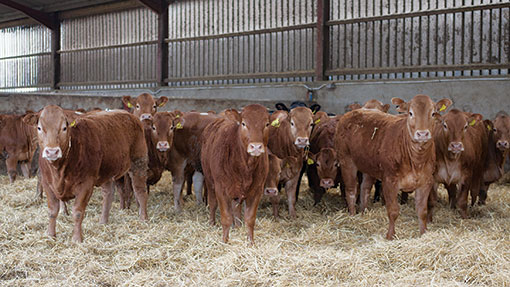Profit from continental beef cross finishing

As continental beef calf prices continue to rise, is there still money to be made in finishing them? Gemma Claxton reports
Optimising growth rates by feeding consistent high-quality rations has seen one Scottish farmer increase profits by knocking at least two months off slaughter ages, and improve his number of U grade steers by 30%.
Sandy Scott of Dukewell Farm, Aberdeenshire, has also saved 150 tonnes of silage a year, while at the same time increasing the throughput of cattle by a third, making all these improvements worth an impressive £10,650 a year.
Mr Scott, runs three enterprises; 104 mainly Limousin x beef cattle, sheep and spring barley, 50-60% of which is grown to feed the livestock.
With calf prices increasing, Mr Scott had to find a way to reduce production costs. He did this with the help of Rob Gilchrist, Keenan nutritionist, by making the most of home-grown ration ingredients. Mr Scott now feeds two consistent total mixed rations – a grower and a finisher – including high-quality protein in the grower ration.
“Last year calves cost £600-700, now they are £150 a head more expensive. Charolais of a similar age and quality will cost £1,200-1,300. I would like more, but they are just too pricey. I buy in 6- to 12-month-old naturally reared calves with a bit of shape to achieve an R grade or better,” says Mr Scott.
Ration changes
The ration has changed from adlib silage, barley and wheat dark grains, to a diet containing more straw, less silage and soya as the protein source in the grower ration.
“Although we used 50 more bales of straw a year in the rations, 150 fewer tonnes a year of silage was needed, saving Mr Scott £3,400. The soya was chosen to complement the silage in the grower ration as it is a good-quality protein source (54%). It is not needed in the finisher ration as the silage is good enough quality,” explains Mr Gilchrist.
Mr Gilchrist’s advice to farmers struggling to finish cattle is to look at how the diet is presented as this plays a big part in how it performs in the stomach. “A good ration on paper can easily be disabled through poor presentation. Chop length needs to be muzzle width, make sure all concentrates are well incorporated and the forage is not over-processed.”
Mr Scott feeds the calves the grower ration until turn-out in late May to early April. In August the grower ration is fed again, but over 7 to 10 days this changes to the finisher ration, avoiding acidosis and rumen upset.
“The animals do much better on these rations, it is so visible you can’t fail to be impressed. The cattle are very content, it is something you notice when you go on to the farm, you can look in on them at any time and they don’t get up,” he adds.
Profitable performance
As a result of the diet change and fewer digestive upsets, age at slaughter has dropped from 24 months to 18 months old.
Even though they were 10kg lighter, margins still improved by £90 an animal due to the time and money saved on feed costs. In fact, Mr Scott has seen a 13.5% improvement in feed conversion efficiency and is now getting 110kg of beef for every tonne of DM.
“Some may say selling at a lighter weight wastes money, but I’ve saved money through time, and the older the animal gets, the slower the feed conversion ratio is, so getting them to slaughter quicker is better,” says Mr Scott.
And with a 10p/kg uplift for a U grade, quality carcasses can really drive up profits. But it’s not just the top end that has seen improvement, O grades have been eliminated and Mr Scott has also seen a reduction in R grades.
He puts the improvements down to the combination of nutritional advice and using a mixer wagon to feed a consistent ration as it avoids checks in growth. “Rob made use of what I wanted to include and the mixer has exceeded my expectations,” says Mr Scott.
“Before there would be greedy animals pushing others out the way to get at the best bits. Now it’s all an identical mix there is no bullying. The fact that the animals are now so calm means they are not wasting energy being stressed.”
RATION DETAILS
Grower (£1.40 a head fed for five months)
- 32.6 % DM
- 11.03 MJ of ME
- 15.3 % CP
Ingredients (kg)
Pot ale syrup 1.00
Wheat straw 0.50
Beef mineral 0.10
Soya 0.33
Barley- rolled 1.00
Grass silage 17.50
Finisher (£2 a head fed for two to three months)
- 51.2 % DM
- 11.96 MJ of ME
- 13.0 % CP
Ingredients (kg)
Pot ale syrup 1.25
Beef mineral 0.15
Wheat straw 0.70
Barley- rolled 8.50
Grass silage 12.5
